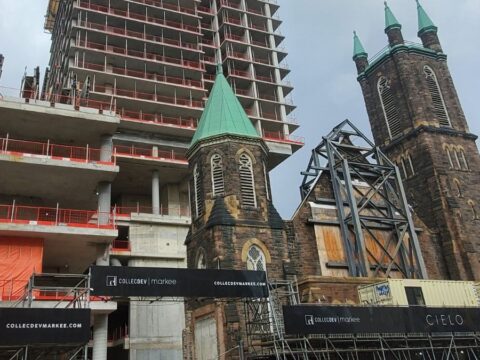A recent decision to dissolve the National Indigenous Council over concerns it wasn’t working has drawn fire from Elders in the Indigenous United church and calls for a review of the denomination’s administration and reversal of General Secretary Rev. Michael Blair’s action.
“We are spiritual people who walk in a spiritual way with our people and have our ways to deal with things,” Evelyn Day, an Elder and an Indigenous General Council commissioner, told The United Church of Canada’s General Council at its annual meeting Oct. 19. “This has spiritually harmed us. You need to be accountable for that.”
You may unsubscribe from any of our newsletters at any time.
Day and at least two other Elders who spoke at the meeting were protesting Blair’s move in mid-August to dissolve the current NIC against their wishes as well as his plans to hold a National Indigenous Spiritual Gathering (NISG) later this month so that the group can elect a new NIC. The NISG is a meeting of all Indigenous communities of faith that usually happens every three years and serves as the top authority in the Indigenous church. The NIC is an elected governing body in the Indigenous church that meets regularly between NISGs to make decisions.
Six Indigenous commissioners — Day, Elder Eileen Antone, Rev. Teresa Burnett-Cole, Russel Burns, Elder Donna Kennedy and Elder Janet Root — had submitted a proposal to the General Council meeting, calling for Blair’s decision to be reversed and the church’s administration reviewed but — over the Elders’ objections — the General Council voted to pass the matter to the General Council Executive (GCE), which next meets from Nov. 22 to 23.
Moderator Rt. Rev. Carmen Lansdowne spoke in support of sending the proposal to the GCE. “There are things happening in the Indigenous church that should not be discussed in this space … Not everyone has the same information. Out of an abundance of care and respect, it is right” to have the GCE deal with the proposal, she said.
Troubles within the NIC
Problems arose at the NIC’s April meeting when the council voted to remove the existing chair, due to perceived incompetence, and elect new co-chairs. The chair objected and filed a complaint with Blair, who upheld the NIC’s decision. In July, some NIC members — unhappy with the chair’s removal — appealed to the church’s judicial committee, which also upheld the NIC’s decision. In the midst of this, one of the new co-chairs resigned in May and the other in August. Both later requested to be reinstated. Later still, one was reinstated.
Members of the NIC told Broadview they wished to hold a healing circle to contend with the problems in the NIC and move forward. They said they were working with national office staff member Lori Ransom, acting executive minister of Indigenous ministries and justice, to set a date for the circle. The members said three dates were proposed in July and September where eight members could attend, which would have made a quorum. (At the Oct. 19 General Council meeting, Moderator Rt. Rev. Carmen Lansdowne said it had not been possible to have a quorum.)
More on Broadview:
- Vote establishing Indigenous church’s self-determination passes
- Indigenous artist’s mural designs in Port Alberni church represent hope and healing
- Want to decolonize your church? Here’s one place to start.
But on Aug. 13, Blair sent a letter to the NIC and the National Indigenous Elders Council (NIEC) saying he and staff were organizing an NISG for November where the issues troubling the NIC would be resolved and a plan to set up a new council would be created.
The letter says, in part, “It is our considered view that the most helpful course of action in the circumstances is to call upon Indigenous communities of faith to send representatives to a National Indigenous Spiritual Gathering (NISG) in November 2024. … It has become clear that we need direction from the NISG.”
A subsequent letter goes on to state: “The present NIC will be dissolved, and at the upcoming National Indigenous Spiritual Gathering, [communities of faith] will be appointing new members. The NISG is being asked to determine a process for the appointment of a new NIC to carry on the work of the Indigenous church. It will be important for all the circles to use the same process for the appointment of members to council.”
Indigenous church members react
Indigenous commissioner Root told the Oct. 19 meeting that Blair’s letter was dismissive and treated NIC members as “insubordinate school children.
“This hearkens to the days gone by. Has little changed in the United Church with Indigenous people?” she asked. “Dissolving the NIC was a cause of harm. Further, it raises the issue that [Blair’s] authority may have overstepped. Certainly, the wishes of the communities of faith and Indigenous circles have been disregarded during the process. I question the decision that was made to dissolve the NIC.”
The six Indigenous commissioners’ proposal holds that Blair transgressed his authority in dissolving the NIC. It calls for “correction of this action” to assure the self-determination of the Indigenous church and change the “colonial process of the United Church Administration.”
That would mean suspending the decision to dissolve the NIC and not making any decisions affecting the Indigenous church without collaborating with the NIC. The proposal also requested that a committee of three Indigenous and two non-Indigenous people review the administration’s actions and report back on the United Church’s commitment to reconciliation.
The proposal stressed the need for the United Church to prove the recent remit, which cleared the path for the Indigenous church to decide its future, “was not simply lip service … This proposal would restore [the Indigenous Church’s] autonomy.”
In her response at the Oct. 19 meeting, Lansdowne told the Elders it was inappropriate to discuss the performance of a staff member in a General Council meeting. “How the tone of the letter was received was certainly, I don’t think, meant to be dismissive or patronizing and was meant to uplift the National Indigenous Spiritual Gathering as the body that had the authority to discern our way forward,” Lansdowne said.
Elder Evelyn Day wasn’t cowed. “The person who dissolved this had no right to be in the position to stop the NIC when they wanted to move forward … that person spiritually violated the NIC, and that has to stop,” she said.
Antone agreed with Day. “I still feel that our NIC should not have been dissolved. The moderator should have just turned it back over to the NIC because that’s what self-determination is,” she said.
Blair defends decision
After the meeting, Blair told Broadview that the NIC had become “non-functional and so we simply said, ‘Let’s pause it.’
“Through the whole process of the remit, the understanding is that the Indigenous Church would come back to say, ‘This is how we see the relationship’ … the NISG has not had that conversation yet,” he said. “…And so the decision was to call the NISG back together to determine how it wants to move forward, given that the NIC was not functioning.”
He also spoke to the recent remit on the future of the Indigenous church, which passed earlier this year after being voted on by the wider denomination and was formally enacted at the Oct. 19 General Council meeting.
“The question that the church tested [in the remit] was an autonomous Indigenous church within the United Church. It wasn’t an independent Indigenous church,” Blair said. “And so, as an autonomous church within the United Church, what are the relationships to the existing structure of the church? Those conversations haven’t taken place yet.”
Day responded to Blair’s comments in an interview with Broadview. “The General Secretary did not say let’s pause it. He said, let’s dissolve it.”
“All we are asking for is the right to be autonomous,” she said. “We were already working to sort out our problems and to find a way forward. Those conversations had already begun. These comments are spiritually dishonest.”
***
Julie Carl is a Toronto freelance journalist.
With files from Emma Prestwich















This is not a “good look” for the General Secretary or General Council. As an observer at this meeting I witnessed the following: at 11:30 am, I heard applause as we ratified the Remit for Indigenous Self-Governance, and by 2:30 pm, those same members of General Council invalidated a Proposal from the Indigenous Commissioners seeking to reconstitute the National Indigenous Council and asking for accountability for the General Secretary and GCO . Pleas of Indigenous Elders to be allowed to proceed in their own way fell on deaf ears.
The Moderator aligned with the Business Table to create a motion referring the Proposal to GCE. The Elders urgently expressed that the matter needed to be heard at the whole Council. They were ignored. The Moderator changed the wording of the motion while it was being voted on. Ignoring the wishes of the Indigenous Commissioners, the matter was referred to GCE.The Elders sought assurance that they would be part of that conversation. They were not invited. It appears the only Indigenous voices that were heard are those on the payroll of General Council. Now it appears the leadership of the National Indigenous Counsel is being orchestrated by “head office” through strategic scheduling and very fluid rules of order.
The United Church of Canada took more than 20 years from the Call for Unity to forming the Church. Do we really expect that the Indigenous Church will be fully functioning within a few months? I share the Indigenous Commissioners concern that we are doing nothing more that “paying lip-service” to Indigenous Self-Determination and that we are being “spiritually dishonest” into the bargain. This is not my understanding of Truth and Reconciliation.
Seems to me that the ‘official church’ leadership slapped down the Indigenous church leadership with an all too familiar power. We empower the indigenous leadership but whack them down when they don’t play nice.